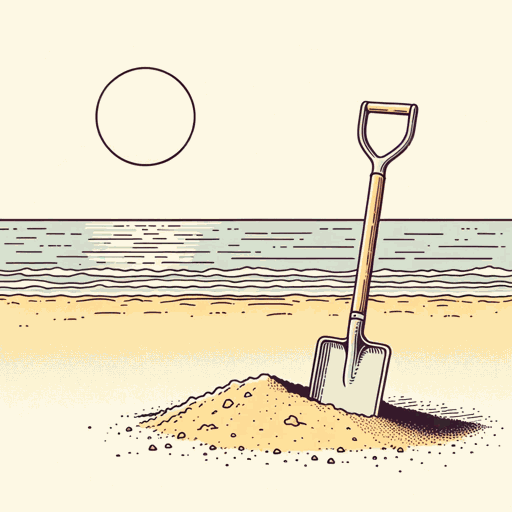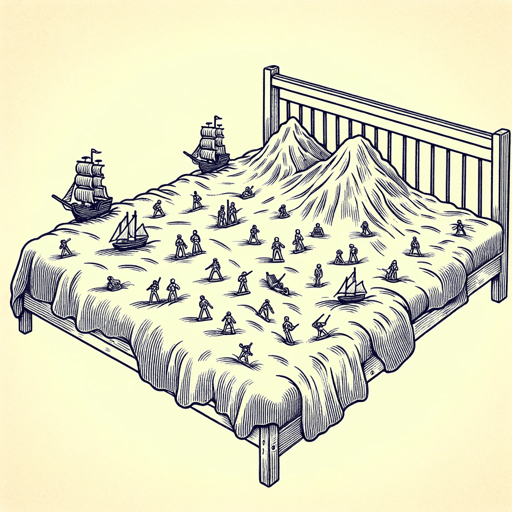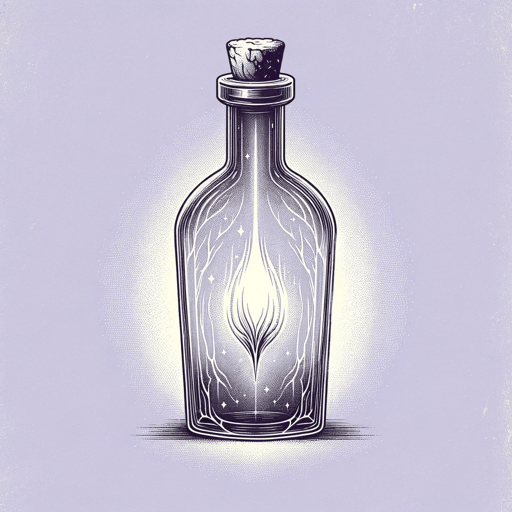31 pages • 1 hour read
Robert Louis StevensonThe Bottle Imp
Fiction | Short Story | Adult | Published in 1891A modern alternative to SparkNotes and CliffsNotes, SuperSummary offers high-quality Study Guides with detailed chapter summaries and analysis of major themes, characters, and more.
Summary and Study Guide
Summary: “The Bottle Imp”
Robert Louis Stevenson’s “The Bottle Imp” is a short and comedic story in the parable genre. The story features themes of Self-Sacrifice for Love, Money Can’t Buy Happiness, and The Reality of Evil. “The Bottle Imp” was first published as a serialized newspaper story in 1891 and was included in Stevenson’s collection, Island Nights’ Entertainment (1893). The story is a humorous take on the trope of “making a deal with the devil,” where the protagonist, rather than the devil, triumphs. Its Hawaiian setting was inspired by Stevenson’s travels in the Pacific. It is one of Stevenson’s best-known short stories.
Stevenson, a Scottish writer, is most famous for his novels Treasure Island and The Strange Case of Dr. Jekyll and Mr. Hyde. He is known for his adventure stories and is sometimes considered a writer for children, but critics have recognized the depth of thematic material in his work despite the trappings of adventure stories. “The Bottle Imp” reflects Stevenson’s interest in issues of morality and his admiration for the culture of Hawaii and the Pacific region, as well as his humor and gift for entertainment. “The Bottle Imp” is told by a narrator who speaks as if telling a familiar story, perhaps a story of someone they know personally. The story primarily relies on third person, with occasional intrusions from the narrator in the form of asides.
This guide refers to a version of the text that is freely available on the website for the Association for Scottish Literary Studies.
“The Bottle Imp” begins with a brief prologue. Stevenson mentions that the story to follow is conceptually the same as a story rendered popular by O. Smith. Despite these similarities, Stevenson hopes he “made it a new thing” (Prologue). He states that the tale has been recreated for Polynesian readers, though he acknowledges that these changes may make the story feel too removed for readers in other parts of the world.
After the Prologue, the story itself begins. Keawe is a young Indigenous Hawaiian man who is poor but intelligent, brave, and hard working. He finds a job as a sailor in order to visit distant cities and, on a journey to San Francisco, happens upon a wealthy neighborhood full of beautiful homes on a hill. He meets an old man living there, who invites him inside one of the houses. Keawe is surprised that the old man seems unhappy and says that if he lived in the house he would never be sad. The old man tells Keawe he can also have such a fine home and explains that the secret to his fortune is a magical bottle containing an imp. The bottle grants wishes to the person that owns it; however, there are some conditions to this good fortune. One is that the bottle must always be sold to someone else for less than the owner originally paid for it—it cannot be given away or destroyed. The bottle cannot be used to wish for immortality. Most importantly, whoever owns the bottle will be eternally damned as long as he owns it. If the owner dies with the bottle in his possession, he will go to hell. The owner may use the bottle to get what he desires, but he must sell the bottle before death to escape this damnation.
Keawe is initially skeptical, but the old man persuades him to try a demonstration. Keawe buys the bottle for $50 and then wishes for his money back. The money appears, and Keawe is frightened by the realities of the bottle and the possibility that he might now be damned. However, the old man refuses to buy back the bottle, saying, “It is yours now; and, for my part, I am only concerned to see the back of you” (Paragraph 32).
Keawe makes several attempts to get rid of the bottle and, after realizing that he is stuck with it, returns to his ship. There he confides in his friend and shipmate Lopaka, who advises him that they might as well use the bottle to gain some good before they get rid of it. Lopaka tells Keawe that he will buy the bottle from him once Keawe has fulfilled his wish for a house; Lopaka wants to buy a schooner and start a trading business.
When they return to Hawaii, they receive word that Keawe’s uncle and cousin have drowned, leaving Keawe to inherit his uncle’s land and just enough money to build his dream house. Initially, Keawe is devastated, but Lopaka counsels him to take the good while he can. Keawe orders the house to be built and resolves to make no more wishes.
Lopaka wants to test the truth of the bottle before buying it and persuades Keawe to ask the imp to appear. Its appearance is so terrifying that both men cannot speak and sit in silence for a long while. Reluctantly, Lopaka fulfills his end of the bargain and takes the bottle with him, humorously remarking that he hopes they “both get to heaven in the end in spite of the devil and his bottle” (Paragraph 85).
Keawe lives in his house, nicknamed the Bright House, and is happy there, becoming famous all over the island for his good fortune and beautiful home. He meets a lovely young woman named Kokua and she promises to marry him. However, he realizes shortly after the proposal that he has been infected with leprosy. Rather than living in exile or selfishly keeping his disease secret, he resolves to find the bottle and brave damnation for a cure. Lopaka has long ago left on his schooner, but Keawe traces a trail of wealth and misery until he finds the current owner of the bottle.
The owner is a young man who has resorted to the bottle to escape the consequences for embezzling money. He is relieved to see Keawe but gives him terrible news: The price for the bottle has fallen so low that Keawe must buy it for one cent. This means that there is no lower price available and that Keawe will be stuck with the bottle and damned. Keawe agrees to the price, reasoning that this man risked everything for his crimes but Keawe will be braver for a nobler cause—love.
However, after his marriage to Kokua, Keawe cannot be happy. He is plagued by nightmares of hellfire and eventually his misery causes Kokua to lose her joy as well. She finally asks him why he married her if she has caused him so much misery, and he explains the bottle and the deal he made. Kokua declares herself no “common girl” and promises that she has a solution (Paragraph 150). She takes them to Tahiti, where the coinage is the centime, much lower than a cent, and where they will have opportunities to sell the bottle for a lower price.
Once in Tahiti, they find that the islanders are suspicious of witchcraft and refuse to purchase the bottle even though it promises great wealth. Kokua decides to sacrifice her soul for her husband since he had done the same to be with her. Kokua knows that Keawe will not allow her to purchase the bottle, so she asks a kindly old man to purchase the bottle for four centimes and promises him she will buy it back for three. She hesitates momentarily to repurchase the bottle, and the old man pities her and offers to keep the bottle. She cannot allow herself to damn the old man, so she eventually purchases it back despite her hesitation.
Now, the roles are reversed—Keawe is overjoyed, but Kokua can find no happiness while she contemplates losing her soul. Keawe is secretly ashamed that he is rejoicing at the old man’s damnation, not knowing about the other transaction that occurred after. Keawe mistakes Kokua’s gentle defense of the man’s motives as evidence that she does not love him. He goes out carousing with friends to celebrate his freedom and to forget the fight.
When he is out drinking, Keawe meets the boatswain, a drunken former criminal, who tells him that women are untrustworthy and hints that Kokua might be unfaithful. Rushing home to catch her in the act, Keawe instead spies her with the bottle and realizes what she has done for him. He repents of his selfishness and asks the boatswain to buy the bottle for two centimes and says he will buy it back for one, damning himself for good this time but freeing his wife from the curse.
In a comic ending, the boatswain is pleased by the bottle and declares himself its new owner, despite his former skepticism about Keawe’s story. Since he believes he was going to be damned anyway, he thinks he should enjoy the pleasures offered by the bottle. Free of the bottle’s curse, the two lovers return to Hawaii and live happily for the rest of their days in the Bright House.
Related Titles
By Robert Louis Stevenson

At the Sea-Side
Robert Louis Stevenson

Kidnapped
Robert Louis Stevenson

Markheim
Robert Louis Stevenson

Requiem
Robert Louis Stevenson

The Black Arrow
Robert Louis Stevenson

The Land of Counterpane
Robert Louis Stevenson

The Master of Ballantrae
Robert Louis Stevenson

The Strange Case of Dr. Jekyll and Mr. Hyde
Robert Louis Stevenson

Treasure Island
Robert Louis Stevenson

